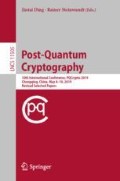Abstract
The speed of NTRU-based Key Encapsulation Mechanisms (KEMs) in software, especially on embedded software platforms, is limited by the long execution time of its primary operation, polynomial multiplication. In this paper, we investigate the potential for speeding up the implementations of four NTRU-based KEMs, using software/hardware codesign, when targeting Xilinx Zynq UltraScale+ multiprocessor system-on-chip (MPSoC). All investigated algorithms compete in Round 1 of the NIST PQC standardization process. They include: ntru-kem from the NTRUEncrypt submission, Streamlined NTRU Prime and NTRU LPRime KEMs of the NTRU Prime candidate, and NTRU-HRSS-KEM from the submission of the same name. The most-time consuming operation, polynomial multiplication, is implemented in the Programmable Logic (PL) of Zynq UltraScale+ (i.e., in hardware) using constant-time hardware architectures most appropriate for a given algorithm. The remaining operations are executed in the Processing System (PS) of Zynq, based on the ARM Cortex-A53 Application Processing Unit. The speed-ups of our software/hardware codesigns vs. purely software implementations, running on the same Zynq platform, are determined experimentally, and analyzed in the paper. Our experiments reveal substantial differences among the investigated candidates in terms of their potential to benefit from hardware accelerators, with the special focus on accelerators aimed at offloading to hardware only the most time-consuming operation of a given cryptosystems. The demonstrated speed-ups vs. functionally equivalent purely software implementations vary between 4.0 and 42.7 for encapsulation, and between 6.4 and 149.7 for decapsulation.
This paper is partially based upon work supported by the U.S. Department of Commerce/National Institute of Standards and Technology under Grant no. 70NANB18H218, as well as the National Science Foundation under Grant no. CNS-1801512.
Access this chapter
Tax calculation will be finalised at checkout
Purchases are for personal use only
References
NTRU Open Source Project. https://github.com/NTRUOpenSourceProject
IEEE Standard Specification for Public Key Cryptographic Techniques Based on Hard Problems over Lattices, P1363.1-2008, March 2009
Aysu, A., Yuce, B., Schaumont, P.: The future of real-time security: Latency-optimized lattice-based digital signatures. ACM Transact. Embed. Comput. Syst. (TECS) 14(3), 43 (2015)
Bailey, D.V., Coffin, D., Elbirt, A., Silverman, J.H., Woodbury, A.D.: NTRU in constrained devices. In: Koç, Ç.K., Naccache, D., Paar, C. (eds.) CHES 2001. LNCS, vol. 2162, pp. 262–272. Springer, Heidelberg (2001). https://doi.org/10.1007/3-540-44709-1_22
Bernstein, D.J., Chuengsatiansup, C., Lange, T., van Vredendaal, C.: NTRU Prime, August 2017. https://ntruprime.cr.yp.to/ntruprime-20160511.pdf
Chen, C., Hostein, J., Whyte, W., Zhang, Z.: NIST PQ Submission: NTRUEncrypt A lattice based encryption algorithm, May 2018. https://www.onboardsecurity.com/nist-post-quantum-crypto-submission
Farahmand, F., Ferozpuri, A., Diehl, W., Gaj, K.: Minerva: automated hardware optimization tool. In: 2017 International Conference on ReConFigurable Computing and FPGAs (ReConFig), pp. 1–8. IEEE, December 2017
Farahmand, F., Sharif, M.U., Briggs, K., Gaj, K.: A high-speed constant-time hardware implementation of NTRUEncrypt SVES. In: 2018 International Conference on Field Programmable Technology (ICFPT) (2018)
Ferozpuri, A., Gaj, K.: High-speed FPGA implementation of the NIST round 1 rainbow signature scheme. In: International Conference on ReConFigurable Computing and FPGAs (ReConFig 2018), pp. 1–6. IEEE, December 2018
Ghosh, S., Delvaux, J., Uhsadel, L., Verbauwhede, I.: A speed area optimized embedded co-processor for McEliece cryptosystem. In: 23rd International Conference on Application-Specific Systems, Architectures and Processors (ASAP), Delft, Netherlands, 9–11 July 2012, pp. 102–108. IEEE (2012). https://doi.org/10.1109/ASAP.2012.16
Hoffstein, J., Pipher, J., Silverman, J.H.: NTRU: a ring-based public key cryptosystem. In: Buhler, J.P. (ed.) Algorithmic Number Theory, pp. 267–288. Springer, Heidelberg (1998). https://doi.org/10.1007/BFb0054868
Howe, J., Oder, T., Krausz, M., Güneysu, T.: Standard lattice-based key encapsulation on embedded devices. IACR Transact. Cryptogr. Hardw. Embed. Syst. 2018(3), 372–393 (2018). https://tches.iacr.org/index.php/TCHES/article/view/7279
Hülsing, A., Rijneveld, J., Schanck, J.M., Schwabe, P.: NTRU-HRSS-KEM: algorithm specifications and supporting documentation, November 2017. https://csrc.nist.gov/CSRC/media/Projects/Post-Quantum-Cryptography/documents/round-1/submissions/NTRU_HRSS_KEM.zip
Kamal, A.A., Youssef, A.M.: An FPGA implementation of the NTRUEncrypt cryptosystem. In: 2009 International Conference on Microelectronics - ICM, pp. 209–212, December 2009
Koziel, B., Azarderakhsh, R.: SIKE - supersingular isogeny key encapsulation: VHDL implementation, November 2017. https://sike.org
Kuo, P.C., et al.: High performance post-quantum key exchange on FPGAs. Cryptology ePrint Archive, Report 2017/690 (2017). https://eprint.iacr.org/2017/690
Liu, B., Wu, H.: Efficient architecture and implementation for NTRUEncrypt system. In: 2015 IEEE 58th International Midwest Symposium on Circuits and Systems (MWSCAS), pp. 1–4, August 2015
Liu, B., Wu, H.: Efficient multiplication architecture over truncated polynomial ring for NTRUEncrypt system. In: 2016 IEEE International Symposium on Circuits and Systems (ISCAS), pp. 1174–1177, May 2016
Migliore, V., Real, M.M., Lapotre, V., Tisserand, A., Fontaine, C., Gogniat, G.: Hardware/software co-design of an accelerator for FV homomorphic encryption scheme using Karatsuba algorithm. IEEE Transact. Comput. 67(3), 335–347 (2018)
National Institute of Standards and Technology: Post-Quantum Cryptography, December 2017. https://csrc.nist.gov/Projects/Post-Quantum-Cryptography
National Institute of Standards and Technology: Post-Quantum Cryptography: Round 1 Submissions, December 2017. https://csrc.nist.gov/projects/post-quantum-cryptography/round-1-submissions
Oder, T., Güneysu, T.: Implementing the NewHope-simple key exchange on low-cost FPGAs. In: Fifth International Conference on Cryptology and Information Security, Latin America, La Habana, Cuba, 20–22 September 2017 (2017)
Wang, W., et al.: XMSS and embedded systems - XMSS hardware accelerators for RISC-V. Cryptology ePrint Archive, Report 2018/1225 (2017). https://eprint.iacr.org/2017/138.pdf
Wang, W., Szefer, J., Niederhagen, R.: FPGA-based Niederreiter cryptosystem using binary Goppa codes. In: Lange, T., Steinwandt, R. (eds.) PQCrypto 2018. LNCS, vol. 10786, pp. 77–98. Springer, Cham (2018). https://doi.org/10.1007/978-3-319-79063-3_4. http://caslab.csl.yale.edu/code/niederreiter/
Author information
Authors and Affiliations
Corresponding author
Editor information
Editors and Affiliations
Rights and permissions
Copyright information
© 2019 Springer Nature Switzerland AG
About this paper
Cite this paper
Farahmand, F., Dang, V.B., Nguyen, D.T., Gaj, K. (2019). Evaluating the Potential for Hardware Acceleration of Four NTRU-Based Key Encapsulation Mechanisms Using Software/Hardware Codesign. In: Ding, J., Steinwandt, R. (eds) Post-Quantum Cryptography. PQCrypto 2019. Lecture Notes in Computer Science(), vol 11505. Springer, Cham. https://doi.org/10.1007/978-3-030-25510-7_2
Download citation
DOI: https://doi.org/10.1007/978-3-030-25510-7_2
Published:
Publisher Name: Springer, Cham
Print ISBN: 978-3-030-25509-1
Online ISBN: 978-3-030-25510-7
eBook Packages: Computer ScienceComputer Science (R0)

